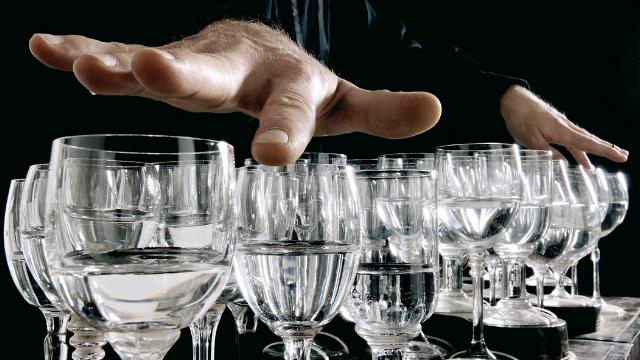The glass harp is a simple concept: fill up a bunch of wine glasses with water, “tuning” each one by varying how much water is inside (because the pitch at which said glass will resonate depends on the level of the water inside). But now you can make a new kind of glass harp, with just a single glass.
It works like a typical glass harp. You just gently rub a moistened finger around the rim, and voila! You get a haunting, ethereal tone. Put a bunch of glasses tuned to a musical scale together and you can play recognisable tunes, like the love theme from Doctor Zhivago. Here, Grace Hart adds a touch of extra ornamentation by ringing a little bell for emphasis. Except she didn’t need all those glasses to work her magic.
New Scientist reports on a new paper in Physical Review E analysing the acoustics behind the glass harp by a couple of physicists. In the process, they came up with an inverted version of the traditional instrument: an empty wine glass submerged in a basin filled with water. Basically, the same mathematical equations work for both versions of the glass harp: the single glass is a mirror image of the transitional glass harp.
Even better, you only need a single wine glass rather than an entire row of precisely tuned glasses — so it’s not a total disaster if your fellow beauty queens get thirsty and drink up your talent right before the final competition. With the inverted glass harp, you vary the pitch by moving the glass up and down in the water. It’s the depth of submersion that determines the resonant frequency in that case. The two physicists — Daniel Quinn and Brian Rosenberg — even managed to crank out a few bars of “Mary Had a Little Lamb”.
Fun historical fact: the first glass harp was the creation of an 18th century Irish guy named Richard Pockrich (or Poekrich, Puckeridge, or Pokeridge — folks in the 18th century were a wee bit sloppy about spelling, even in official records). He called it the “angelic organ”. Pockrich started out in a life of privilege, inheriting a decent amount at 25, but he didn’t have much of a head for business — or luck in his speculative ventures. He tried raising geese, building an observatory (he was a big fan of astrology), had a madcap scheme for a series of canals connecting the rivers Liffey and Shannon, and lost two separate runs for Parliament. He married late, at age 50, but his wife ran off with an actor.
But out of one of his failures — a brewery in Dublin — came his greatest success. He was about to be arrested as a debtor and sent to prison, but entranced the local bailiffs with an impromptu performance on his newly invented glass harp. He got off, and ended up having a nice musical career late in life, touring around England playing his “angelic organ.” Misfortune caught up with him again, alas: he died in a London fire in 1759, and his instrument also perished in the flames.
(h/t: New Scientist)
Citation: Daniel B. Quinn and Brian J. Rosenberg (2015) “Inverted Glass Harp,” Physical Review E 92: 021003(R).
